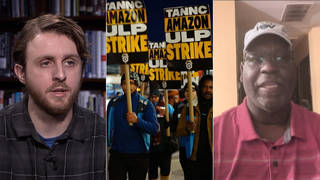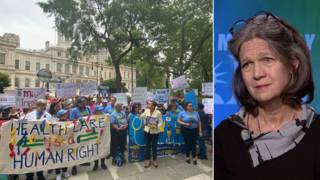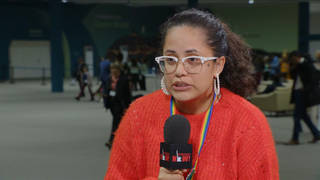
Related
By Amy Goodman
Nearing 87 years old, Yuri Kochiyama lives in a small room in an Oakland, Calif., senior living facility. Her walls are adorned with photos, posters, postcards and mementos detailing a living history of the revolutionary struggles of the 20th century. She is quiet, humble and small, and has trouble at times retrieving the right word. Yet, with a sparkle in her eyes, she has no trouble recalling that incredible history—not from books, not from documentaries, but from living it, on the front lines.
February marks a coincidence of anniversaries in Kochiyama’s incredible life: 66 years ago, on Feb. 19, 1942, President Franklin Delano Roosevelt issued Executive Order 9066, authorizing the mass internment of Japanese-Americans. Then there is Feb. 21, 1965, the day Malcolm X was assassinated at the Audubon Ballroom in New York City.
Kochiyama was a young woman living with her parents in San Pedro, Calif., when Pearl Harbor was attacked. Within hours, her father was arrested by the FBI. She recalled:
“[The FBI agents] said, ‘Is there a Seichi Nakahara living here?’ I said, ‘He just came home from ulcer surgery.’ And they went in and got him—it was done so quickly, it didn’t even take a half of a minute, I don’t think. And I didn’t dare ask a question. They were going out the door immediately. And then, I just called my mother, who was right down the street to say, ‘Come home quick. The FBI just came and took Pop.’ ”
He was taken to the San Pedro Hospital, where U.S. sailors and Marines who had been injured in the Japanese attacks were also being treated. Kochiyama’s father was the only person of Japanese descent in the hospital. They put him in a bed behind a sheet marked “Prisoner of War.” Kochiyama recalled what her mother said: “When she saw the reaction of all the American [patients] who were just brought in from Wake Island, she didn’t think he was going to last. And so, she asked the head of that hospital, could he be given a room by himself, and then when he was feeling better, could they take him … to the prison, because that hospital, she said, was probably worse than prison, because here were all these Americans who had been injured.”
He was released six weeks later, returned home in a state of extreme illness. Kochiyama recalls: “He came home, it was around dinnertime, 5:30. And they had a nurse come with him. And by the next morning, she woke us up and said, ‘He’s gone.’ ” Her father had died.
Yuri and the rest of her family were rounded up and sent to Rohwer Camp in Arkansas as part of the internment of more than 120,000 Japanese-Americans. Nearly 70,000 of them were U.S. citizens. She spent more than two years imprisoned there. She married after her release, and she and her family eventually moved to Harlem, N.Y.
Yuri was a changed woman. Her experience made her aware of the lack of justice suffered not only by Asian-Americans, but by African-Americans and Latinos as well. She met Malcolm X in 1963. They became friends and allies. He sent her postcards from his transformative trip to Africa. She was in the audience at the Audubon Ballroom in Harlem when he was shot.
She ran up onto the stage: “Malcolm had fallen straight back, and he was on his back. And so I just went there and picked up his head and just put it on my lap. People ask, ‘What did he say?’ He didn’t say anything. He was just having a difficult time breathing. I said, ‘Please, Malcolm, please, Malcolm, stay alive.’ But he was hit so many times.”
Malcolm X’s assassination propelled Kochiyama further into a life committed to the struggle for social justice, human rights, racial equality and prisoner rights. She is a staunch supporter of Mumia Abu-Jamal, who has lived on death row in Pennsylvania for a quarter of a century.
As the Bush administration asserts its authority to detain “enemy combatants” without charge, and zealots in Congress hatch plans to round up 12 million people accused of being “illegal aliens” (100 times the number of Japanese-Americans interned), we all have timely lessons to learn from Yuri Kochiyama.










